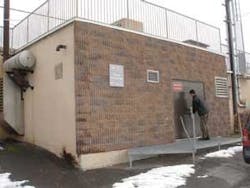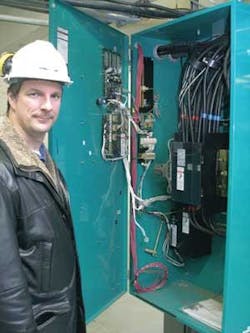Water Pump Station Demonstrates Success of Alternate Power Solution
Transfer switch from Cummins Power Generation re-energizes peak-shaving program at Quebec’s Hydro Sherbrooke.
About 10 years ago, Hydro Sherbrooke, a large municipal electric utility, began a program of discounts to commercial and institutional customers willing to operate their standby generators during periods of peak demand. The program would save participating customers money and allow the utility to shed electrical load and reduce strain on its system.
The program languished, though. At participating customers’ facilities, the approved open-transition transfer switches caused a short power interruption when the facilities’ loads were switched from the utility to the generator set. This caused lights to go out momentarily and machinery to stop and also put computer data at risk. This lapse was often unacceptable during normal business hours for the participating commercial and industrial customers. A technician also was required to manually operate the transfer switch, adding to the inconvenience. The program was revitalized when Cummins Power Generation came up with a solution in cooperation with Hydro Sherbrooke, a closed-transition transfer switch.
The utility, however, didn’t allow closed-transition switches because of the danger that a running standby generator could inadvertently feed power back into utility lines that the utility thought were off. Under certain circumstances, this could put linemen at high risk. Cummins sponsored a test of a new closed-transition transfer switch to convince the utility a redesigned closed-transition transfer switch could operate safely.
The innovative new device fully automated generator starting and power transfer without a power interruption to the customer’s loads. And Cummins redesigned its switch to detect any failure to connect or disconnect properly, thereby preventing a standby power system from an inadvertent sustained connection to the utility. The successful test installation convinced the utility to amend its equipment recommendation on transfer switches to allow use of newly designed closed-transition transfer switches.
Operational Differences
“Transfer switches are critical pieces of equipment in all standby generator installations,” says Benoit Parent, of Cummins Eastern Canada, the local distributor for Cummins Power Generation. “Open-transition transfer switches are commonly used in basic standby generator installations where the generator is only called upon to operate automatically when the utility power fails. The switch senses the failure and breaks the connection between the utility and the building’s electrical load and sends a start signal to the generator.”
When the generator starts and gets up to speed, the switch connects the generator to the building’s electrical load, usually within about 10 seconds. When utility power comes back on, the transfer switch waits for a short time to be sure the utility doesn’t fail again, then opens the connection to the generator set, reconnects the facility’s load to the utility and shuts down the generator after a cool-down period.
A closed-transition transfer switch functions automatically in the same way as an open-transition switch when utility power fails, but differently on retransfer of power from the generator to the utility. Instead of disconnecting from the generator before connecting the utility to the customer’s load, the closed-transition transfer switch parallels the generator and the utility for less than 100 milliseconds. The advantage of closed-transition is that, under testing or load-shedding modes, customers can automatically or remotely shift from utility to generator-supplied power with no noticeable interruption in power to the load.
Making Sure It Works
To demonstrate the safety and reliability of the closed-transition transfer switch, a six-month test at a utility-owned pumping station was conducted. The station lifts water to more than 5,000 residents and a local hospital in a high part of the service area. A 300 kW Cummins diesel generator provides standby power for three 100-hp pumps in the event of a utility failure. Originally intended to provide only basic standby power, the installation also included an open-transition transfer switch from another manufacturer. Under utility failure conditions, the switch worked properly; but, when the utility instituted its load-shedding program and wanted to shed the 300 kW pumping load during peak demand periods, a technician had to go to the pumping station to manually start the generator and operate the switch. This was also the case at the 22 other commercial customers on the load-shedding program who had open-transition transfer switches.
“The new closed-transition transfer switch was installed because load shedding was not really practical with the open-transition switch,” says Pierre Frechet, division chief of special projects for Hydro Sherbrooke. “We had to have someone at the facility manually transfer the pumping motors to the generator set. Two of our participating customers have large, paralleling systems and protective relays to prevent back-feeding. But all the others still were using open-transition transfer switches with the exception of our pumping station.”
“At first, the people in charge of the pumping station were skeptical about it,” says Parent, “but they said if they could reestablish the site for load-shedding, the utility would regain the ability to shed 300 kW of load when necessary – and then gradually revitalize the load-shedding program to its customer base.”
Test with a Guarantee
Cummins agreed to buy back the new transfer switch if it didn’t work as promised during the six-month test and pay to re-install the original equipment. Afterward, all agreed the closed-transition transfer switch operated reliably and safely in all modes with no manual intervention. The transfer switch includes fail-to-open and fail-to-close monitoring for both power contactors involved in the transfer. Company engineers were able to demonstrate that in all conceivable modes of transfer switch failure, the switch would never fail in a closed position.
“The switch also has something we call the ‘watchdog relay,’” says Parent. “If the switch is paralleled with the utility for more than 500 milliseconds (a period of time set by the utility), it will try to open the utility side of the switch. If that’s unsuccessful, then it will try to open the generator side of the switch. If neither attempt is successful, then it trips the breaker on the generator. Hydro Sherbrooke engineers studied our engineering designs for several months and they decided that the switch was reliable enough to always fail in the safe (not paralleled with the grid) condition.”
Conclusion
As a result of the test, Hydro Sherbrooke has reinstituted its load-shedding program, allowing closed-transition transfer switches with the reliability and protective features found in the Cummins Power Generation switch on customer power systems up to 600 kW. The financial incentives for customers with standby power systems to participate in the peak-shaving program are significant. During the high peak demand periods of the later afternoon and early evening, power can cost significantly more than at other times of the day. By self-generating power at a lower cost than the utility charges at these peak times, customers are able to reduce their overall energy expenditures. In addition, the utility benefits from reduced strain on its electrical grid, increasing its integrity and often deferring construction of peaking plants and power lines.
Cummins Power Generation, a subsidiary of Cummins Inc., is based in Minneapolis, Minnesota, USA. Contact: 763-574-5942 or www.cumminspower.com



